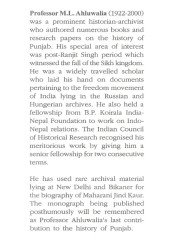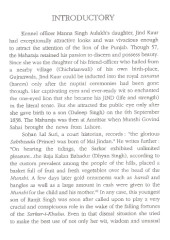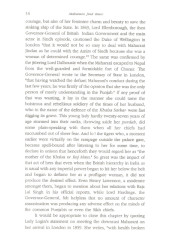Monday to Saturday - 10:00 Am to 9 PM
Now Enjoy Bulk Discounts on Books as Mentioned Below
These Discounts are in addition to the Discounts on Individual Books (Visible as Bulk Discount for Books in Cart)
Extra 10% Off If Books Purchased Exceeds Rs 3000 or 75 USD or 60 GBP or 60 Euro or 100 AUD or 100 CAD
Extra 15% Off If Books Purchased Exceeds Rs 6000 or 150 USD or 120 GBP or 120 Euro or 200 AUD or 200 CAD
Extra 20% Off If Books Purchased Exceeds Rs 15000 or 225 USD or 180 GBP or 180 Euro or 300 AUD or 300 CAD
Extra 25% Off If Books Purchased Exceeds Rs 30000 or 300 USD or 240 GBP or 240 Euro or 400 AUD or 400 CAD
Introduction of The Book ‘Maharani Jind Kaur’ By ML Ahluwalia
Kennel officer Manna Singh Aulakh's daughter, Jind Kaur had exceptionally attractive looks and was vivacious enough to attract the attention of the lion of the Punjab. Though 57, the Maharaja retained his passion to discern and possess beauty. Since she was the daughter of his friend-officer who hailed from a nearby village (Chichrianwali) of his own birth-place, Gujranwala, Jind Kaur could be inducted into the royal zanana (harem) only after the nuptial ceremonies had been gone through. Her captivating eyes and ever-ready wit so enchanted the one-eyed lion that she became his JIND (life and strength) in the literal sense. But she attracted the public eye only after she gave birth to a son (Duleep Singh) on the 6th September 1838. The Maharaja was then at Amritsar when Munshi Govind Sahai brought the news from Lahore.
Sohan Lal Suri, a court historian, records : "the glorious Sahibzada (Prince) was born of Mai Jindan." He writes further : "On hearing the tidings, the Sarkar exhibited unlimited pleasure...the Raja Kalan Bahadur (Dhyan Singh), according to the custom prevalent among the people of the hills, placed a basket full of fruit and fresh vegetables over the head of the Munshi. A few days later gold ornaments such as hansli and bangles as well as a large amount in cash were given to the Munshi for the child and his mother."1 In any case, this youngest son of Ranjit Singh was soon after called upon to play a very crucial and conspicuous role in the wake of the falling fortunes of the Sarkar-i-Khalsa. Even in that dismal situation she tried to make the best use of not only her wit, wisdom and unusual courage, but also of her feminine charm and beauty to save the sinking ship of the State. In 1843, Lord Ellenborough, the men Governor-General of British Indian Government and the main actor in Sindh episode, cautioned the Duke of Wellington in London "that it would not be so easy to deal with Maharani Jindan as he could with the Amirs of Sindh because she was a woman of determined courage."2 The same was confirmed by the jittering Lord Dalhousie when the Maharani escaped to Nepal from the well-guarded and formidable fort of Chunar. The Governor-General wrote to the Secretary of State in London, "that having watched the defiant Maharani's conduct during the last few years, he was firmly of the opinion that she was the only person of manly understanding in the Punjab." If any proof of that was wanting, it lay in the manner she could tame the boistrous and rebellious soldiery of the times of her husband, who in the name of the defence of the Khalsa Sarkar were fast digging its grave. This young lady hardly twenty-seven years of age stormed into their ranks, throwing aside her purdah, did some plain-speaking with them when all her chiefs had succumbed out of sheer fear. And lo ! the tigers who, a moment earlier were virtually on the rampage outside the palace gate, became spell-bound after listening to her for some time, to declare in unison that henceforth they would regard her as "the mother of the Khalsa or Raj Mata." So great was the impact of that act of hers that even when the British hierarchy in India as is usual with any imperial power began to hit her below the belt and began to defame her as a profligate woman, it did not produce the desired effect. Even Henry Lawrence, a moderate amongst them, began to mention about her relations with Raja Lal Singh in his official reports, while Lord Hardinge, the Governor-General, felt helpless that no amount of character assassination was producing any adverse effect on the minds of the common Punjabis or even the Sikh chiefs.
It would be appropriate to close this chapter by quoting Lady Login's statement on meeting the downcast Maharani on her arrival in London in 1859. She writes, "with health broken and eye-sight dimmed, her once famed beauty vanished in an air of lassitude, it was hard to believe in her former charms of person and of conversation." However, the fact of the matter was that in spite of formidable misfortunes, the lioness in Maharani Jind Kaur refused to be tamed. Before her death she told her son Duleep Singh that her dead body be not cremated in the land of the deceitful and avaracious imperialists but taken to Punjab for cremation. This desire of hers was allowed by the British, but only partially. Surely her spirit could not be barred from searching her land of birth.
It is a well-known fact that a person's character and intelligence could be easily judged by his/her speech and writing. The Maharani was actually a very gifted person in respect of her penmanship as well as eloquence. Some of her personal letters which have survived and are to be found in the National Archives of India bear testimony to this fact. These letters exhibit the clarity of her mind and her sense of timing. This leaves no doubt that her father had given her the best available education and that she was proficient in Gurmukhi. Another very distinct feature of her personality was her ringing voice which had an air of royalty in it, in the same way as that of Queen Elizabeth-I of England. She was undoubtedly the most indomitable and determined person which we come across in the post-Ranjit Singh era. If she had not been gifted with all these qualities, she would have succumbed either to the pleasures of sex or to political debauchery. Major Broadfoot, the British political agent at Ludhiana, himself confirmed at one time that she was a past master in the art of State-craft and used one chief against another as the situation called 'for.
Preface To The Book ‘Maharani Jind Kaur’ By ML Ahluwalia
I am obliged to Professor Prithipal Singh Kapur (formerly Pro-Vice-Chancellor, Guru Nanak Dev University, Amritsar) for persuading me to do this historical biography of Maharani Jind Kaur. This indeed gave me an opportunity to make an in-depth study of the turbulent events enveloping the short life-span of the valiant Maharani. As I sifted the vast archival material, I developed a strong feeling that even we historians have betrayed the unfortunate Maharani by not having paid full attention to the struggle that she waged; almost single-handed, to thwart the British designs. It is another matter that she was not destined to meet with success.
I conclude with an appeal to fellow-scholars to make an intensive and dispassionate study of all those patriots who dared resist the might of British imperialism to uphold the honour and dignity of the country as also the people of this sub-continent.
New Delhi
28th December 1994 M.L. AHLUWALIA
About the Author ‘ML Ahluwalia ' of the Book Maharani Jind Kaur
Professor M.L. Ahluwalia (1922-2000) was a prominent historian-archivist who authored numerous books and research papers on the history of Punjab. His special area of interest was post-Ranjit Singh period which witnessed the fall of the Sikh kingdom. He was a widely travelled scholar who laid his hand on documents pertaining to the freedom movement of India lying in the Russian and Hungerian archives. He also held a fellowship from B.R Koirala India-Nepal Foundation to work on Indo-Nepal relations. The Indian Council of Historical Research recognised his meritorious work by giving him a senior fellowship for two consecutive terms.
He has used rare archival material lying at New Delhi and Bikaner for the biography of Maharani Jind Kaur. The monograph being published posthumously will be remembered as Professor Ahluwalia's last contribution to the history of Punjab.
Table of Contents of The Book ‘Maharani Jind Kaur’ By ML Ahluwalia
| CONTENTS | ||
| —Editorial Note | 7 | |
| —Preface | 11 | |
| 1 | Introductory | 13 |
| 2 | The Hiatus after Ranjit Singh | 16 |
| 3 | The Queen Mother | 23 |
| 4 | The Journey Downhill | 39 |
| 5 | The Smouldering Embers | 50 |
| 6 | The Flutterings and Resistance | 63 |
| 7 | Forging Rebellion | 72 |
| 8 | Sheikhupura, Banares and Chunar | 90 |
| 9 | The Last Phase : Kathmandu and the End | 106 |
| —Appendix A | 119 | |
| —Appendix B | 126 | |
| —Appendix C | 128 | |
| —Index | 133 |
| Books | |
| Author | ML Ahluwalia |
| Pages | 140 |
| Cover | Hardbound |
| Language | English |
Maharani Jind Kaur - Book By ML Ahluwalia
- Brand: Singh Brothers
- Product Code: ESE113
- Availability: In Stock
-
Rs.300.00
Related Products
Land Marks In Sikh History - A Fully Researched And Documented History : 1699 - 1947 - Book By ML Ahluwalia
About The Author Of 'Land Marks In Sikh History - A Fully Researched And Documented History : 169..
Rs.500.00
Sunset of The Sikh Empire - Book by Sita Ram Kohli
Table of Contents For 'Sunset of The Sikh Empire' - Book by Sita Ram Kohli ..
Rs.425.00
The Sikhs and Transfer Of Power - Book By Dr. Kirpal Singh
Table of Contents For 'The Sikhs and Transfer of Power' - Book By Dr. Kirpal Singh &n..
Rs.180.00
Hardinge Papers Relating To Punjab - Book By Dr. Kirpal Singh
Foreword To 'Hardinge Papers Relating To Punjab' By Dr. Kirpal Singh 'Hardinge Papers relat..
Rs.160.00
Tags: books on famous sikhs, books on popular sikhs, books on sikh martyrs, books on sikh rulers, books on sikh warriors maharani, jind, kaur, ahluwalia, eminent, english











